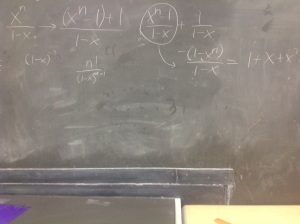Earlier today I wrote about one of my AP Calculus BC students who wowed me with his solution to a particularly thorny algebraic problem. I referred to being outclassed by him as he saw something I did not think of AT ALL in the problem. This tale is about someone seeing something I saw – but something I did not expect my students to remember. This involved verifying the derivative of an awkward trig expression. Below is a snapshot I took and then I will try to detail the work and the conversation.
The students were asked to show that the derivative of (sin x)^2 /(1 + cot x) + (cos x)^2 /(1 + tan x) is equal to – cos 2x
I said out loud that my first instinct was that it would be nice to somehow get my Pythagorean identity in the numerator together. Boy it is nice to see both cosine squared and sine squared. Well, the hero of my first post shrugged and said he just attacked the quotient rule derivative here. Another student, named Samarth, had followed a path similar to the one I imagined. It is his work that I show above. He patiently talked the class through his thinking and his work and, in the process, showed that he had a strong memory of helpful trig definitions. This problem is a nasty one if you just lower your head and plow through. Samarth did not show interest in doing that, he wanted a more elegant touch to bring to play just as Connor had in the earlier post from today. In the same class as these two is another boy, named Daniel, who wowed me last week by applying the binomial theorem to a problem asking us to prove that numbers of the form 7^n – 1 are always multiples of 6. I have been in school for 9 days now and this class alone has knocked my socks off three times already.
I have been having great conversations in my other classes as well and I will be highlighting some of those soon.
It has been a pretty terrific start to the year and I am optimistic that more awesomeness lies ahead.

